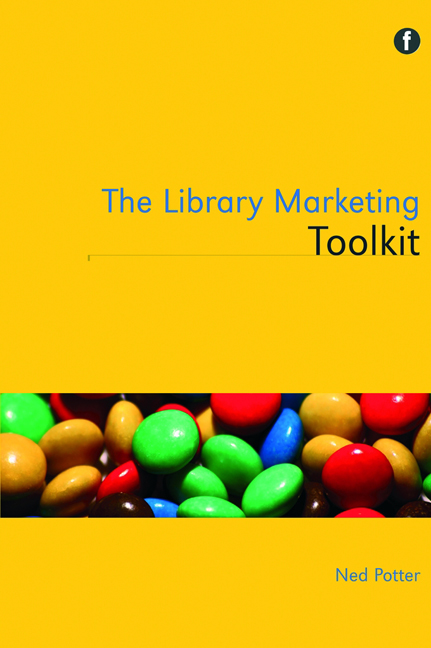Book contents
- Frontmatter
- Dedication
- Contents
- Acknowledgements
- Introduction
- 1 Seven key concepts for marketing libraries
- 2 Strategic marketing
- 3 The library brand
- 4 Marketing and the library building
- 5 An introduction to online marketing
- 6 Marketing with social media
- 7 Marketing with new technologies
- 8 Marketing and people
- 9 Internal marketing
- 10 Library advocacy as marketing
- 11 Marketing special collections and archives
- A final word on marketing libraries
- Appendix: Glossary of Web 2.0 tools and platforms
- References
- Index
- Frontmatter
- Dedication
- Contents
- Acknowledgements
- Introduction
- 1 Seven key concepts for marketing libraries
- 2 Strategic marketing
- 3 The library brand
- 4 Marketing and the library building
- 5 An introduction to online marketing
- 6 Marketing with social media
- 7 Marketing with new technologies
- 8 Marketing and people
- 9 Internal marketing
- 10 Library advocacy as marketing
- 11 Marketing special collections and archives
- A final word on marketing libraries
- Appendix: Glossary of Web 2.0 tools and platforms
- References
- Index
Summary
The previous several chapters have focused on technology, but now it is time to bring the spotlight back to those aspects of marketing that involve the Participants (from Booms and Bitner's Seven Ps model, 1981) – in other words, the people. Pitching to people, marketing with other people, reaching people remotely and utilizing other people to get your message out for you, are all pulled together and covered in this chapter. It is divided into two: Collaborating with people, and Reaching people.
There are three case studies. The first gives a really useful insight into how the media works, courtesy of journalist Rob Green. Oriana Acevedo from the State Library of New South Wales, Australia, gives some advice on marketing to multicultural communities in the second case study, and lastly Joanna Wood of Cafcass talks us through reaching remote users, on a budget.
Collaborating with people
The chapter starts with an exploration of one of the single most important techniques in marketing libraries today.
Word-of-mouth marketing
The power and importance of wordofmouth marketing (or WOMM) are beyond dispute. WOMM is simply one or more people telling others about a product, service, institution or brand. In effect, it is the process of letting others market on your behalf, in this case by telling their friends and acquaintances about how good your library is. A certain amount of WOMM will happen without any intervention from the library: people talk to each other about good and bad experiences all the time. The aim here is to harness this as a marketing tool, and exert some kind of influence on the content of the messages going out, how th're disseminated, and who hears them.
There are countless statistics taken from research on the subject – for example that 67% of all consumer decisions are primarily influenced by word of mouth (Court et al., 2010). Customers identify word of mouth as the most reliable source for ideas and information on products and services; people prefer to use something if it's been recommended to them by someone they trust – it really is that simple. Recommending services or brands to wide audiences has never been easier than in this age of social media. So how can libraries use all this to their advantage? WOMM is quite cheap and very effective, but does require some planning and management.
- Type
- Chapter
- Information
- The Library Marketing Toolkit , pp. 139 - 152Publisher: FacetPrint publication year: 2012



